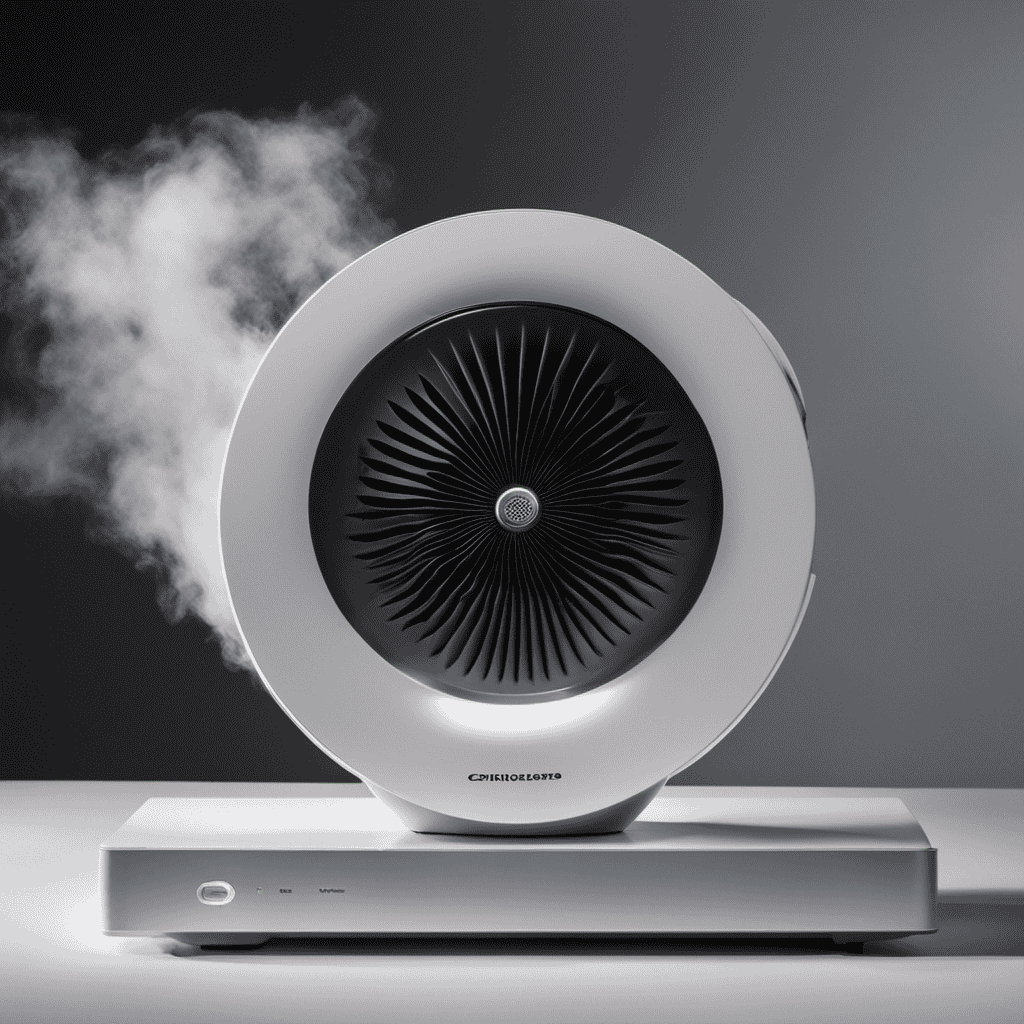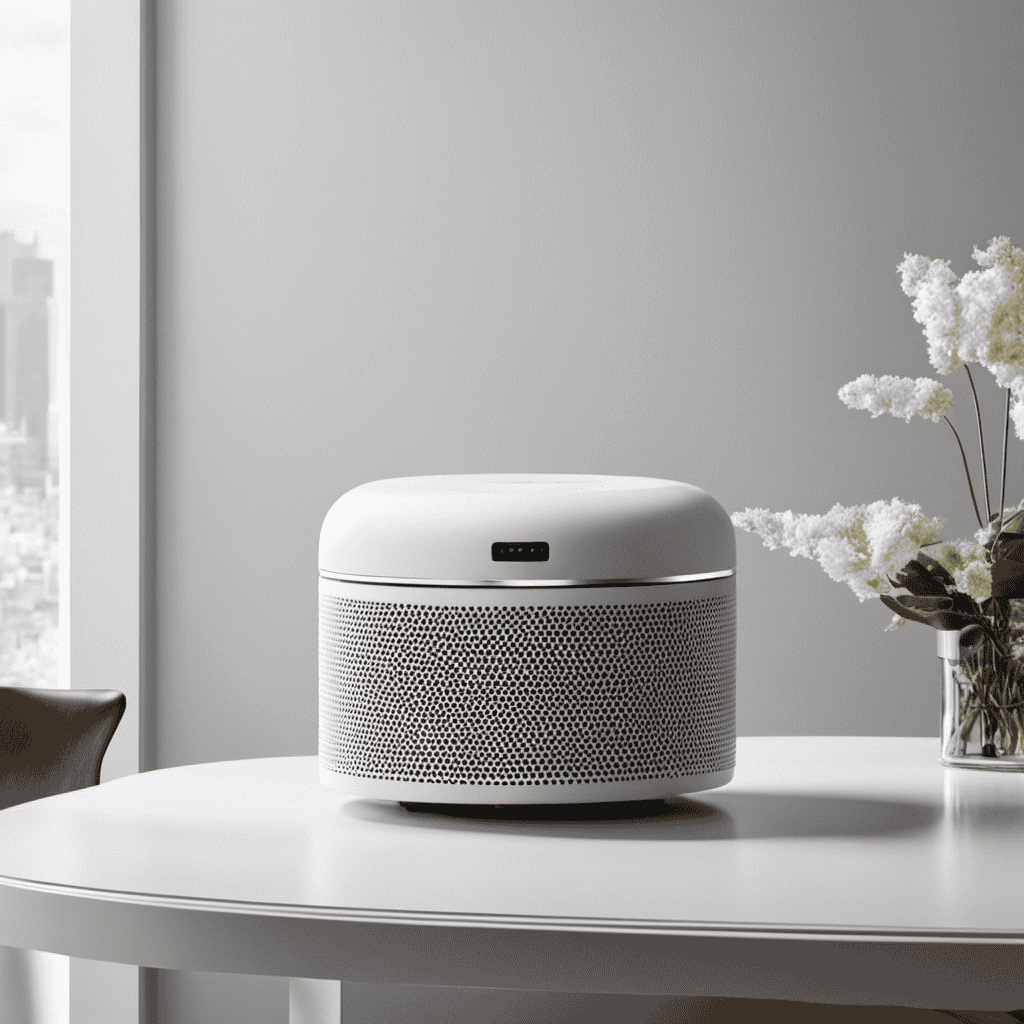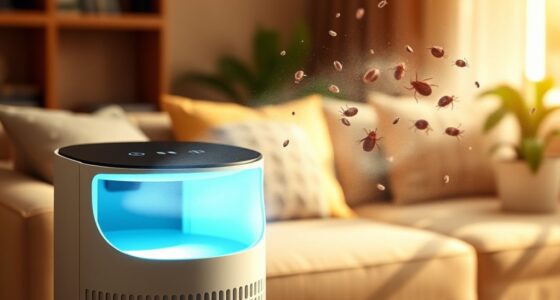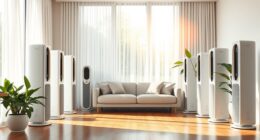I have frequently pondered about the source of that irritating white powder on my air purifier. Through research and analysis, I have identified several possible reasons.
Poor quality air filters, hard water residue, high humidity levels, excessive use of humidifiers, improper maintenance, tobacco smoke residue, pet dander and hair, pollen and outdoor allergens, and even mold and mildew growth can all contribute to this problem.
In this article, I will delve into each of these factors and provide a scientific understanding of what could be causing that annoying white dust.
Key Takeaways
- White dust on air purifiers can indicate poor air quality and indoor air pollution.
- Common sources of air pollution include fine particulate matter, VOCs, and chemical emissions.
- Air pollution can have negative impacts on health, leading to respiratory problems, cardiovascular diseases, and even lung cancer.
- Regular maintenance, proper use of humidifiers and air purifiers, and addressing air pollution sources are important for improving indoor air quality and ensuring a healthier living environment.
Poor Quality Air Filters
One possible reason for the white dust on the air purifier could be that the poor quality filters are not effectively trapping and removing particles from the air. When it comes to air purifiers, filters play a crucial role in maintaining air quality.
High humidity levels can cause dust particles to stick together and become more visible. If the filters are of poor quality, they may not have the necessary efficiency to effectively capture and retain these particles, resulting in the white dust buildup on the air purifier.
It is important to choose filters that are specifically designed for high humidity environments and have a high filter effectiveness rating. Regular maintenance and replacement of filters can also ensure optimal performance and prevent the accumulation of white dust on the air purifier.
Hard Water Residue
The hard water residue can leave a white film on your air purifier. This occurs when the minerals in the water evaporate and settle on the surfaces of the purifier. To effectively deal with hard water stains on your air purifier, consider the following cleaning methods:
-
Vinegar Solution: Mix equal parts of vinegar and water and use a cloth or sponge to gently scrub the affected areas. Rinse thoroughly with clean water afterward.
-
Lemon Juice: Squeeze fresh lemon juice onto a cloth or sponge and rub it onto the stains. Let it sit for a few minutes before wiping it clean.
-
Baking Soda Paste: Mix baking soda with water until it forms a paste. Apply the paste to the stains and let it sit for a few minutes. Scrub gently and rinse with water.
-
Commercial Hard Water Stain Removers: There are various products available specifically designed to remove hard water stains. Follow the instructions on the product for best results.
Regular cleaning and maintenance can help prevent the buildup of hard water stains on your air purifier, ensuring it continues to function effectively.
High Humidity Levels
When it comes to air purifiers, understanding the relationship between humidity and their performance is crucial.
One common issue is condensation and the resulting white dust that can accumulate on the purifier’s surfaces. This occurs when moisture in the air combines with the minerals present in hard water, causing the dust to settle.
Additionally, high humidity levels can affect the overall effectiveness of air purifiers by increasing the moisture content in the air, making it harder for the purifier to filter out pollutants effectively.
Moreover, excessive humidity can also lead to the growth of mold and mildew on the filters, reducing their lifespan and potentially releasing harmful spores into the air.
Condensation and White Dust
Condensation can lead to the formation of white dust on an air purifier. This occurs when moisture in the air comes into contact with the cool surfaces of the purifier and condenses, leaving behind mineral deposits.
To prevent condensation and the subsequent white dust, there are several steps you can take:
-
Maintain proper humidity levels in your home. Use a dehumidifier if necessary to keep the air dry.
-
Regularly clean and maintain your air purifier. Follow the manufacturer’s instructions for cleaning and replacing filters.
-
Use distilled or demineralized water in humidifiers or air purifiers that require water for operation.
-
Consider using an air purifier with a built-in humidifier, as these models are designed to control moisture levels more effectively.
Moisture and Air Purifiers
To prevent moisture buildup and maintain optimal performance, it’s important to follow proper cleaning and maintenance guidelines for your air purifier.
Regular maintenance ensures that the air purifier continues to function effectively and efficiently, providing you with clean and fresh air.
Cleaning the filters regularly is a crucial part of air purifier maintenance, as it helps remove dust, allergens, and other particles from the air. By doing so, air purifiers can help improve indoor air quality, reduce allergies and asthma symptoms, and create a healthier living environment.
Additionally, air purifiers can help eliminate odors and remove harmful pollutants, such as smoke and volatile organic compounds (VOCs), from the air.
Proper maintenance not only prolongs the lifespan of your air purifier but also ensures that it continues to provide you with the numerous benefits of using air purifiers.
As humidity can have significant effects on filters, let’s explore how it impacts the performance of your air purifier.
Humidity Effects on Filters
Maintaining proper humidity levels in your home can greatly impact the effectiveness of your air purifier’s filters. Here’s how humidity control affects filter lifespan:
-
High humidity: Excess moisture in the air can cause mold and mildew to grow on the filters, reducing their efficiency and lifespan.
-
Low humidity: Dry air can cause the filter material to become brittle and less effective at capturing particles, leading to a shorter filter lifespan.
-
Optimal humidity: Keeping the humidity levels between 40-60% can help maintain the filters’ performance and prolong their lifespan.
-
Humidifier use: If you use a humidifier, ensure it has proper maintenance to prevent excessive moisture in the air, which can lead to filter damage.
Excessive Use of Humidifiers
Humidifier residue can cause dust buildup in the air, which can have a negative impact on air quality.
When the humidifier releases moisture into the air, any minerals or impurities present in the water can become airborne and settle as dust particles.
These particles can then circulate throughout the room, leading to decreased air quality and potential respiratory issues for individuals.
Humidifier Residue Causing Dust
The white dust on your air purifier could be caused by humidifier residue. When using a humidifier, mineral deposits from hard water can accumulate on surfaces, including the air purifier. Here are some cleaning tips to help remove the residue and prevent the formation of white dust:
-
Use distilled water: Using distilled water in your humidifier can help minimize mineral buildup and reduce the amount of residue left on your air purifier.
-
Regularly clean the humidifier: Cleaning your humidifier regularly, as per the manufacturer’s instructions, can prevent the buildup of mineral deposits and reduce the amount of residue that ends up on your air purifier.
-
Use a soft cloth or brush: Gently wipe or brush away any visible residue on the air purifier. Avoid using abrasive materials that could damage the surface.
-
Consider using a water treatment solution: Some humidifiers come with water treatment solutions that can help reduce mineral buildup and prevent the formation of white dust.
Impact on Air Quality
After discussing the issue of humidifier residue causing dust, it is important to understand the broader impact on air quality.
Air pollution sources play a significant role in deteriorating air quality and can have detrimental effects on human health. The presence of white dust on air purifiers could be an indication of indoor air pollution.
Common sources of air pollution include fine particulate matter, volatile organic compounds (VOCs), and chemical emissions from household cleaners or building materials. These pollutants can contribute to respiratory problems, such as asthma and allergies, and can even lead to more serious health issues, including cardiovascular diseases and lung cancer.
It is crucial to address air pollution sources and implement effective strategies to improve indoor air quality, ensuring a healthier living environment for everyone.
Improper Maintenance
To prevent white dust on your air purifier, you should regularly clean and maintain it. Neglecting proper maintenance can lead to several issues, including excessive noise and increased energy consumption. Here are four reasons why regular maintenance is essential:
-
Dust accumulation: Over time, dust and dirt particles can build up on the filters and internal components of the air purifier. This not only reduces its efficiency but also increases the chances of white dust being released into the air.
-
Clogged filters: If the filters are not cleaned or replaced regularly, they can become clogged, obstructing the airflow and causing the air purifier to work harder, resulting in excessive noise and higher energy consumption.
-
Humidity levels: In areas with high humidity, moisture can accumulate inside the air purifier, leading to the formation of mold and mildew. These contaminants can affect the air quality and contribute to the production of white dust.
-
Improper storage: Storing the air purifier in a dusty or dirty environment when not in use can also contribute to the accumulation of dust and white dust particles.
Incorrect Air Purifier Settings
When it comes to incorrect settings on an air purifier, there are a few key points to consider.
Firstly, the filter may not be properly installed. This can lead to reduced efficiency and ineffective air cleaning.
Secondly, having the fan speed set too high can actually lead to poor air circulation and increased noise levels.
Lastly, using the wrong cleaning solution on the purifier can cause damage to the unit and potentially release harmful chemicals into the air.
It is crucial to address these issues in order to ensure optimal performance and maintain a healthy indoor environment.
Filter Not Properly Installed
Make sure you’ve properly installed the filter to prevent any white dust on your air purifier. Improper installation can lead to a variety of risks and issues, including the accumulation of white dust. Here are some maintenance tips to ensure your filter is correctly installed:
-
Read the manufacturer’s instructions: Before installing the filter, carefully read the instructions provided by the manufacturer. This will ensure you have a clear understanding of the installation process.
-
Check for proper fit: Ensure that the filter is the correct size and type for your air purifier. It should fit snugly without any gaps or leaks that can allow dust particles to escape.
-
Securely fasten the filter: Follow the manufacturer’s guidelines to securely fasten the filter in place. This will prevent any air bypass and ensure that all the air passes through the filter.
-
Regularly clean and replace the filter: To maintain optimal performance, clean or replace the filter as recommended by the manufacturer. This will prevent the buildup of dust and ensure efficient filtration.
High Fan Speed
When it comes to air purifiers, another factor that can contribute to the presence of white dust is high fan speed. In some models, the fan speed can be adjusted to different levels, and running the purifier at a high fan speed can cause an increase in the release of white dust particles. This occurs because the higher fan speed can cause the air to pass through the filter more quickly, resulting in less contact time between the air and the filter media. As a result, some of the larger particles, including the white dust, may not be effectively captured and end up being released into the air. To prevent this, it is advisable to adjust the fan speed to a lower setting, allowing for better moisture control and filtration efficiency.
| Possible Cause | Explanation | Solution |
|---|---|---|
| High Fan Speed | Running the purifier at a high fan speed can cause an increase in the release of white dust particles. | Adjust the fan speed to a lower setting for better filtration efficiency. |
This issue can be exacerbated if the wrong cleaning solution is used.
Wrong Cleaning Solution
Using the wrong cleaning solution can further worsen the problem of white dust on an air purifier. It’s important to understand that improper technique and chemical reactions can have a significant impact on the effectiveness of cleaning. Here are four reasons why using the wrong cleaning solution can be detrimental:
-
Incompatibility: Certain cleaning solutions may not be compatible with the materials used in the air purifier, leading to damage or discoloration.
-
Residue buildup: Using a solution that leaves behind residue can result in a buildup of particles on the purifier’s surfaces, including the filters, causing reduced efficiency.
-
Chemical reaction: Some cleaning solutions can react with the particles in the air or the components of the purifier, resulting in the formation of white dust or other unwanted byproducts.
-
Allergen dispersion: Using the wrong cleaning solution may not effectively remove dust mite allergens, allowing them to remain and potentially cause respiratory issues.
It’s essential to choose the right cleaning solution and use proper techniques to ensure the air purifier functions optimally and effectively removes dust mite allergens.
Dust Mite Allergens
The white dust on your air purifier could be caused by dust mite allergens. Dust mites are tiny creatures that live in household dust and feed on dead skin cells. They are a common trigger for allergies and asthma symptoms.
When you use an air purifier, it is designed to capture and remove these allergens from the air, helping to improve indoor air quality. However, it is important to note that air purifier effectiveness in removing dust mite allergens may vary depending on factors such as the type of air purifier, the size of the room, and the level of dust mite infestation.
To prevent dust mites, it is recommended to regularly clean and vacuum your home, wash bedding in hot water, and use dust mite-proof covers on mattresses and pillows.
Tobacco Smoke Residue
After discussing the issue of dust mite allergens, let’s now shift our focus to another potential cause of white dust on air purifiers: tobacco smoke residue.
Tobacco smoke contains tiny particles and chemicals that can settle on surfaces, including air purifiers. Here are a few reasons why tobacco smoke residue may be causing the white dust on your air purifier:
-
Combustion byproducts: When tobacco is burned, it releases combustion byproducts that can accumulate as white dust on your air purifier.
-
Tar and nicotine: Tobacco smoke contains tar and nicotine, which can leave behind sticky residues that contribute to the formation of white dust.
-
Incomplete combustion: Incomplete combustion of tobacco can result in the release of fine particles that settle on surfaces.
-
Air purifier maintenance: Regularly cleaning and maintaining your air purifier can help remove tobacco smoke residue and prevent the buildup of white dust.
As we move forward, let’s explore another potential source of white dust: pet dander and hair.
Pet Dander and Hair
Did you know that pet dander and hair can be a significant source of allergens in your home? Many people suffer from pet allergies, and one of the main culprits is the shedding of pet hair and the presence of pet dander in the air. Pet dander is made up of tiny particles of skin that animals shed, while pet hair can easily become airborne and spread throughout your living space. These allergens can cause symptoms such as sneezing, coughing, and itchy eyes in sensitive individuals. To better understand the impact of pet dander and hair on indoor air quality, let’s take a look at the table below:
| Pet Allergens | Shedding Problems |
|---|---|
| Pet dander | Skin particles |
| Pet hair | Airborne spread |
Pollen and Outdoor Allergens
After discussing the issue of pet dander and hair, it’s important to address another common cause of white dust on air purifiers: pollen and outdoor allergens.
Outdoor pollution, including pollen, can infiltrate our homes and cause discomfort for those with seasonal allergies. Here are some key points to consider:
-
Pollen particles are small and lightweight, making them easily airborne and able to enter our homes through open windows and doors.
-
Air purifiers can help capture and remove pollen from the indoor air, reducing exposure and alleviating allergy symptoms.
-
Regularly cleaning and changing the filters in your air purifier is crucial to maintain its effectiveness in removing pollen and other allergens.
-
It’s also important to keep windows and doors closed during high pollen seasons to minimize the influx of outdoor allergens.
Understanding the impact of outdoor pollution and seasonal allergies on indoor air quality is essential for creating a healthier living environment.
Transitioning from discussing outdoor allergens, let’s now explore another potential cause of white dust: mold and mildew growth.
Mold and Mildew Growth
Mold and mildew can thrive in damp environments, such as bathrooms and basements, leading to potential health risks and the need for proper prevention and remediation. To prevent mold growth, it is important to control moisture levels in the environment.
One effective method is to ensure proper ventilation. Ventilation options include using exhaust fans in bathrooms and kitchens, opening windows to allow fresh air circulation, and using dehumidifiers in areas prone to excessive moisture. These measures help to reduce the humidity and prevent the accumulation of moisture, which in turn inhibits the growth of mold and mildew.
Regular maintenance and cleaning are also crucial in mold prevention. By keeping the environment dry and well-ventilated, the risk of mold and mildew growth can be minimized, ensuring a healthier and safer living space.
Frequently Asked Questions
Can the White Dust on My Air Purifier Be Harmful to My Health?
The white dust on my air purifier raises concerns about potential health risks. To address this, effective cleaning methods should be employed to minimize any potential harm and ensure a healthy indoor environment.
How Can I Prevent White Dust From Forming on My Air Purifier?
To prevent white dust on my air purifier, I clean it regularly. By using a damp cloth or vacuuming the filter, I can remove any accumulated particles and maintain clean air in my home.
Are There Any Specific Air Purifier Models That Are More Prone to Producing White Dust?
Certain air purifier models may be more prone to producing white dust due to factors such as their filtration system or the type of filter used. Regular air purifier maintenance can help minimize the occurrence of white dust.
Is There a Way to Remove White Dust From My Air Purifier Without Damaging It?
To clean white dust from my air purifier without damaging it, I can use a soft, damp cloth to wipe down the surfaces. Regularly changing the filters and keeping the air purifier in a clean environment can help maintain its performance.
Can White Dust on My Air Purifier Indicate a Larger Problem With My Indoor Air Quality?
White dust on my air purifier can be a sign of larger indoor air quality issues. Potential causes include high mineral content in tap water or using a humidifier. Regular cleaning and using distilled water can help remove the dust.
Are the White Dust and Thin White Film on Air Purifiers Caused by the Same Thing?
Yes, the white dust and thin white film on air purifiers are caused by the same thing. Both are typically the result of mineral deposits and other particles that settle on the surfaces of the air purifier. Regular cleaning and maintenance can help reduce the build-up of the thin white film on air purifier.
Conclusion
In conclusion, the presence of white dust on your air purifier can be attributed to various factors. These include poor quality air filters, hard water residue, high humidity levels, excessive use of humidifiers, improper maintenance, tobacco smoke residue, pet dander and hair, pollen and outdoor allergens, as well as mold and mildew growth.
These culprits can invade your air purifier like unwanted guests, compromising its effectiveness. By understanding and addressing these issues, you can ensure a cleaner and healthier environment for yourself and your loved ones.
So, let’s kick out the white dust and breathe in pure, fresh air!










